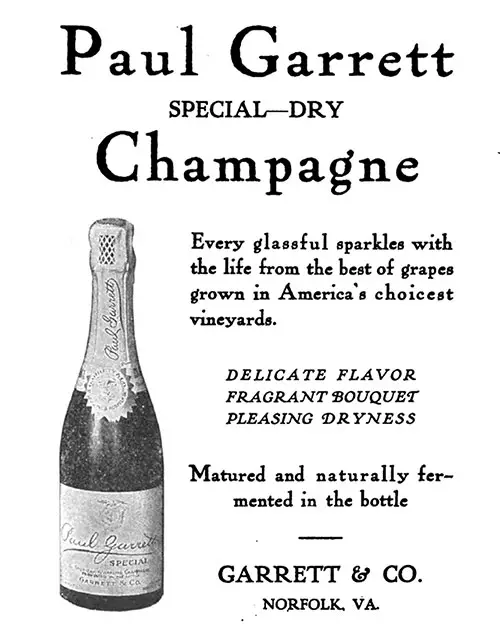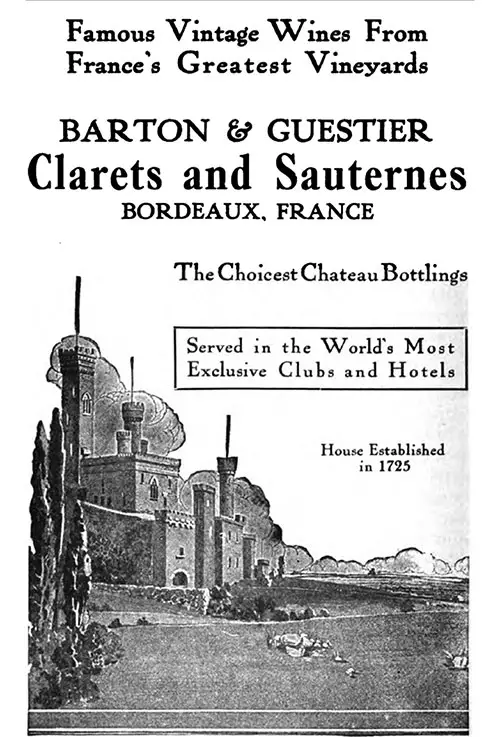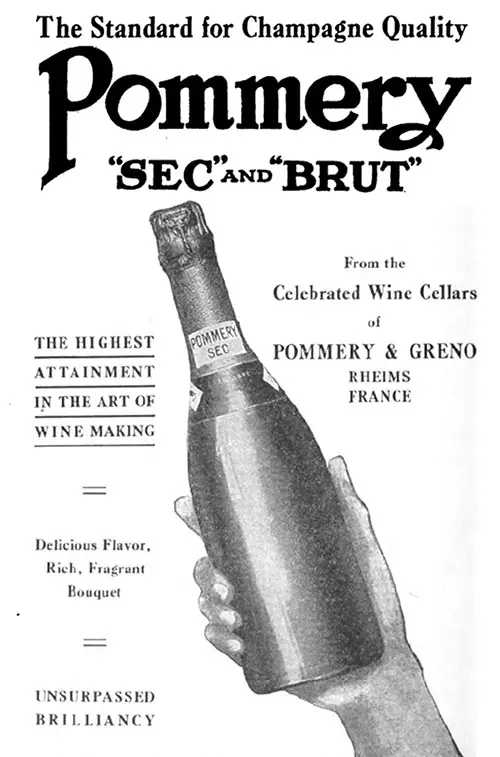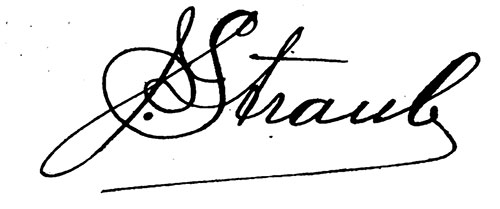Therapeutic Values of Wines - 1913
Mr. Jacques Straub is a native of Switzerland. In early life, he began a careful study of wine culture from the vineyard to the table. He has practiced in all its branches from the work in the field to the scientific study of soils, fermentation, maturing and proper handling of wines. More than that, he has gone deep into the therapeutically, hygienic properties and medicinal uses of alcoholic beverages.
While in Europe, he visited the world-renowned wine districts, made a study of the different methods of production employed by the most celebrated winemakers and distillers, and engaged practically in the distillation of all the known liquors on the market.
On leaving Europe, Mr. Straub went to Louisville, KY where he was soon given charge of the wine department of the Pendennis Club. As wine steward and manager for twenty-one years, he made the wine cellars of that place famous for their wonderful selection of vintages. As an authority on alcoholic beverages, how to care for them, when and how to use them, his reputation is unsurpassed.
ooo-ooo
WHEN TO SERVE BEVERAGES
- Appetizers- Pale dry Sherry with Bitters, Vermouth, Dubonnet or Cocktail
- With Soup - Old Dry Sherry
- With Fish - Rhine Wine, Moselle, Sauternes, White Burgundy
- Entrée - Light Bordeaux Claret
- Roast- Chateau bottled Claret or Red Burgundy
- Game - Vintage Champagne
- Pastry- Rich Madeira
- Cheese- Port
- Fruit- Tokay, Malaga, White Port
- Coffee- Cognac, Liqueurs or Cordials
ooo-ooo
Centuries of experience have confirmed that wine is a marvelous product for man either in health or illness, if he makes judicious use of it, according to his constitution.
High medical authorities and scientists throughout the world acknowledge that wine spirits and malt liquors used as a beverage are very beneficial to health when taken in moderation and are absolutely necessary in many cases of fever, nervous exhaustion, debility and convalescence.
Old people are greatly benefited by daily drinking of good wines in moderate quantity. A poet once said, “that the man who drinks wine must necessarily have more exalted thoughts than he who drinks water.”
Wine invigorates the mind and body and gives life an additional charm, but temperance and moderation are virtues essential to our happiness. The good effect of wines as food is due to their stimulating operation on the nervous system and muscular lining of the stomach, by which the same is excited to greater action and produces a healthy flow of the gastric juices.
Wine being the pure juice of the grape properly fermented and aged is without question a healthful beverage to take with meals, and if those who drink ice water would use wine instead, they would find their digestion better, and their general health improved.
To satisfy the palate of the most critical connoisseur, the best quality of goods, proper handling, conditioning and serving of wines is part of the wine culture.

The Wine that All Champagne – Paul Garrett Special Dry Champagne
Beginning with Champagne, upon receipt of a shipment of champagne or any other sparkling wine, the same should be promptly unpacked and every bottle inspected as to the soundness of the cork. All such that show signs of leakage should be used first, while the others should be stored lying down and be given a rest for several days.
When conditioning Champagne for service, the chilling of the same should be slowly and carefully done by placing the warm bottle in a refrigerator for several hours and not packed in ice until shortly before serving.
Taking wines from the case or shelf and packing them in ice is a very serious mistake, as chilling too quickly robs them of their life and vinosity. Should the time for conditioning be short, place the wine in a bucket of cold water as it runs from the faucet, adding a few lumps of ice every ten to fifteen minutes and in this way preserve the good quality of your wine.
Old vintage wines should be served at a temperature of about 45 degrees while the young vintages showing more life are served best at about 38 degrees. Non-vintage Champagnes may be served at a temperature of 32 degrees.
Upon taking the bottle from the cooler, it should be well wrapped with а napkin, so the warm hand of the waiter will not come in contact with the bottle and agitate the wine. Cap, wire, and string should be carefully removed, head of the bottle cleaned, and the cork slowly drawn so all gas may be retained in the wine.
Care should be taken to have the glasses clean and dry and always to serve the host first. This is an old-time custom which is done to give the host a chance to taste the wine before serving his guests. Glasses should not be filled more than within one-fourth inch from the brim.
The Ritz champagne glass is unquestionably the best and most practical in the serving of sparkling wines because it is compact and does not agitate the wine, as is the case with a hollow stem glass.
The saucer glass being wide, and shallow should never be used, as it gives the wine too much surface, causing the wine to become warm and losing its effervescence quickly.
The proper time for serving Champagne is with the last meat course of the dinner. Being served cold, the carbonic gas becomes “caged” and drinking the same between two warm courses; the gas becomes released, causing one to belch and bring small particles of food into the throat and render the stomach sour.
Having enjoyed a meal of several courses, the gastric juices are not strong enough to properly take care of same and fermentation, creating a gas, sets in before digestion is complete. It is at this time that Champagne will do the work it is intended for and at once relieve you of that oppressive and uncomfortable feeling.
In case of illness, especially typhoid fever, where the stomach has become dormant from not being supplied with solid food for a long time, Champagne should be the first wine given during convalescence.
No matter in what small quantities solid food may be given, it will create a gas which may be easily removed through the use of Champagne, giving comfort to the patient until such a time that the stomach will become strong enough to perform its functions without outside aid.
Since the year of 1870, the following crops have been shipped as vintages: 1870, 1874, 1878, 1880, 1884, 1889, 1892, 1893, 1898, 1899, 1900, 1904, 1906. All authentic vintage wines have the name and year of their production marked on cork and label.

Famous Vintage Wines from France’s Greatest Vineyards – Barton & Guestier Clarets and Sauternes from the Region of Bordeaux, France
Clarets, Sauternes, Burgundies, Rhine and Moselle wines, are, next to champagne, more favorably known than any other, and while books could be written on their cultivation and maturing, below are remarks to their good uses and properties.
Red Burgundies are the richest of all-natural wines, containing a great deal of tannin or iron, and are, for this reason, a very fine blood building tonic. Burgundies, being of very rich body, will form a sediment in the bottle, and before serving the same, should be carefully decanted, without the sediment becoming mixed with the wine, as this would render it bitter and unwholesome. Red Burgundies should be served with dark meats, and at a temperature of about 65 degrees.
White Burgundies are served best at a temperature of about 50 degrees, and like Rhine, Moselle and Sauterne wines, should be used with the fish, oyster or white meat courses of the meal.
Clarets, although not as generally used as champagne, are nevertheless wines of excellent therapeutic value. Their low percentage of alcohol, combined with the tannin, forms a very good tonic in cases of consumption, anemia, debility from overwork and indigestion.
They are a beneficial and curative element. A glass served with your meals, properly assimilated with your food, has a stimulating and health-giving effect. Being the only wine not spoiled by the addition of water, a half a glass so diluted is the most refreshing type of a beverage, and a pleasure to your palate.
When serving claret with your meals, the lighter, but sound types should be served with the entree, while the rich and heavy chateau bottlings are served best with the roast.
They should be served at the temperature of the room in which the meal is served, and like the Red Burgundies, they form sediment and should be carefully decanted.
A good many of the finer class are bottled at the vineyard in which they are grown and are thus known as chateau bottlings. Authentic chateau bottlings have their vintage and crest of the chateau plainly marked on cork and label. The best vintages in the last forty years are as follows: 1870, 1874, 1875, 1877, 1878, 1888, 1893, 1899, 1904.
Sauternes, no doubt on account of their sweetness, are not being given their deserved appreciation. Yet, a better and finer wine, than a Chateau Yquem of a good vintage could not be found the world over.
Sauternes are of a delicate flavor, pale golden color, mellow, rich and have fine, agreeable bouquet. They are hygienic, not heady, and merit the description of perfection in white wines. Their relatively high alcoholic strength is both tonic and stimulating.
Consumed moderately, they are invaluable to convalescents after a severe illness, or when it is necessary to revive an organism extenuated by high fever, hemorrhage, or long fatigue.
For table service, the dry Sauternes should be served with the fish course while the rich and heavy Yquems are perfect dessert wines, and one or two glasses at the end of the meal facilitate digestion and provoke gaiety.
When conditioning Sauternes for the table, they should be chilled slowly, and be served at a temperature of not below 42 degrees. A good many Sauternes are bottled at the chateau, and to be authentic, should be properly marked on cork and label.
The best vintages in recent years are: 1864, 1865, 1869, 1874, 1884, 1887, 1893, 1899, 1904.
Rhine and Moselle's wines have in late years greatly gained in favor, and when the qualities and fineness of these Wines are to be taken into consideration, their increased popularity is well deserved.
Rhine wines have great fragrance and vinosity and are pre-eminently the wines most suitable for intellectual enjoyment, as they are particularly exhilarating and increase the appetite.
Being of light alcoholic strength, but rich in volatile ethers, they are exceedingly efficient and do not (like clarets) so quickly spoil after opening.
The finer qualities widely differ in flavor and being rich in ethers are much valued as a stimulant in sustaining the nervous force of the heart while its enfeebled muscular tissue recuperates.
For serious nervous prostration, their value as a remedy can hardly be overestimated, their beneficial effects being strikingly exhibited in bringing back a stronger and steadier heartbeat, thus calming any attendant irritability which is of the utmost importance to the patient.
Moselle wines are of a quite distinct character, fine, of a grape flavor, very light and delicate, decidedly fruity and known t0 be a most wholesome and refreshing beverage.
The finest growth of the Moselle and its tributary, the River Saar, are Scharzhofberger, Scharzberger, Berncasteler Doctor, Brauneberger, Josephshotel, etc., all widely known for their most delicate bouquet.
Moselle as a highly etheral wine is also very useful in cases of cerebral and cardiac exhaustion; it stimulates the action of the liver and kidneys and is generally credited with being otherwise beneficial. It is anti-diabetic and does not increase the gouty tendency.
In conditioning either Rhine or Moselle wines for the table, they should be chilled slowly to a temperature of from 45 to 50 degrees. In this way, they retain all their quality. The proper time to serve them is with the fish course of your dinner.
A good general rule to adopt in the serving of the different pure grape wines is: Dark meat --> dark wine, White meat --> white wine. The best vintage in recent years in the Rhine and Moselle districts are as follows: 1886, 1893, 1895, 1897, 1900, 1904, 1906.

Pommery Sec and Brut Champagne
Port - The wine commonly known as “Port” is grown along the River Douro, in Portugal, where the same is known as “Vinho do Porto.” On the banks of this river, not far from the city of Oporto, are the vineyards of the Alto Douro.
The vineyards are built in terraces, resembling mammoth stairways, on the steps of which are planted the vines. A great variety of grapes are grown here, and the vintage begins about the middle of September.
Only perfectly ripe grapes are gathered by the army of women performing this work. The pressing of the grapes is very similar to the method used in the Sherry district of Spain.
The fermentation of the must begins almost immediately after the same has been transferred into the casks, but in the production of the richer wines, fermentation is stopped at an early stage, by the addition of young French brandy.
The wines intended for dry Ports are allowed to ferment more thoroughly before brandy is added. When the secondary fermentation is complete, the casks are transported to the cellars of the shipping firms, most of whom are located at Oporto.
Wines from the perfect crops are sold as vintage wines, and a great many are shipped to England, where, at the age of from three to five years, they are bottled.
Port greatly improves in bottles, and care should be taken to use only the very best corks. Bottles should be hermetically sealed either with wax or especially made caps. A well-aged bottle of Port should be carefully decanted before serving, as a good deal of the tannin and tartar settles during maturation.
Port wine, of good quality and old, taken in moderation, is the most wholesome wine produced. Port is especially agreeable when taken with a light repast, biscuit or cake.
For those in delicate health, a glass of Port taken with a repast is a splendid invigorator and will be found very beneficial to those suffering from anemia.
Sherry - The district of Jerez, from which the well-known Spanish wines derive their name of “Sherry” is situated southwest from Jerez de la Frontera to Port St. Mary and north to San Lucar. The principal grapes grown in the Sherry producing districts are the Pedro Jimenez, Palomino, Penimo, Marituo Castellano.
The vintage begins in early September. The grapes are gathered into wooden troughs, and crushed by the bare feet of the workmen, after which they are pressed in an old-fashioned wooden press, from which the juice is pumped into large casks.
Previous to this operation, however, a small quantity of sulphate of lime is sprinkled upon the crushed grapes. This sulphate of lime is produced by burning some native earth, found near Jerez. It is this process which gives the wine its peculiar flavor and develops its volatile ethers, the aroma.
The first racking of the wine takes place in June. The wines are now stored in large casks in the bodegas, where in the course of one- or two-years remarkable changes are brought about, some of the wines developing into Amontillado, others into Oloroso, Basto or Fino, although being made from the same grapes and all receiving the same treatment. Amontillados are extremely dry and of wonderful flavor. Oloroso has a pronounced nutty flavor, darker in color, and heavier body. Basto is the cheapest grade, and not generally shipped.
In very good years, a few casks of wine are kept for the purpose of blending with wines produced in inferior seasons, this imparting to them flavor and body. Wines kept in storage for this purpose are known as “Soleras,” which themselves are replenished by wines from perfect vintages only.
Sherries, possessing a large amount of alcohol, greatly improve with age, and a properly matured old Sherry is unquestionably the peer of any wine. Genuine Sherry, on account of its freedom from acidity and sugar, has great dietetic value. By those who suffer from indigestion, exhaustion, sleeplessness, and general debility, Sherry, properly used, will be found a wonderful tonic.
Madeira - The island of Madeira is the largest of а group belonging to Portugal about five hundred miles southwest of Lisbon and is known for its excellent quality of wine. The grapes mostly cultivated in the production of Madeira are the Malvasia, Vidogua, Sercial, Muscatel, Alicante, Negiamal, and Batardo.
The process of making Madeira wine is the same as applied in the making of Sherries. The gathered grapes are put into troughs and crushed by the naked feet of the harvesters.
The juice, or mosto, is transferred into large casks and allowed to ferment, after which the alcoholic percentage is increased, through the addition of French brandy. This is done to better preserve the quality of the wine.
After the first racking, more brandy is added, this bringing the alcoholic percentage of the wine up to about 18 to 20 регcent. The casks are then removed to the estufas, or heated storage, where they are left for several months.
The heating process assists the formation of ethers, and also destroys all chances for the growth of fungi, which would render the wine bitter and unpalatable.
Another Way to properly mature the finer wines, and which is still in practice by a good many grower, is to send wines in casks on long sea voyages, where the intense heat and constant shaking has a very beneficial effect.
The storing of the casks of wine in the sun also has a beneficial effect, in the proper assimilation and formation of the ethers. The best grades of Madeira wines are the Malmsey, Bual and Sercial. Madeiras possess invigorating properties, and as either an appetizer or tonic are unsurpassed.

Excerpt from Straub's Manual of Mixed Drinks, Chicago: R. Francis Welsh Publishing Company, 1913. Edited by E. B. Gjenvick, 2019.
